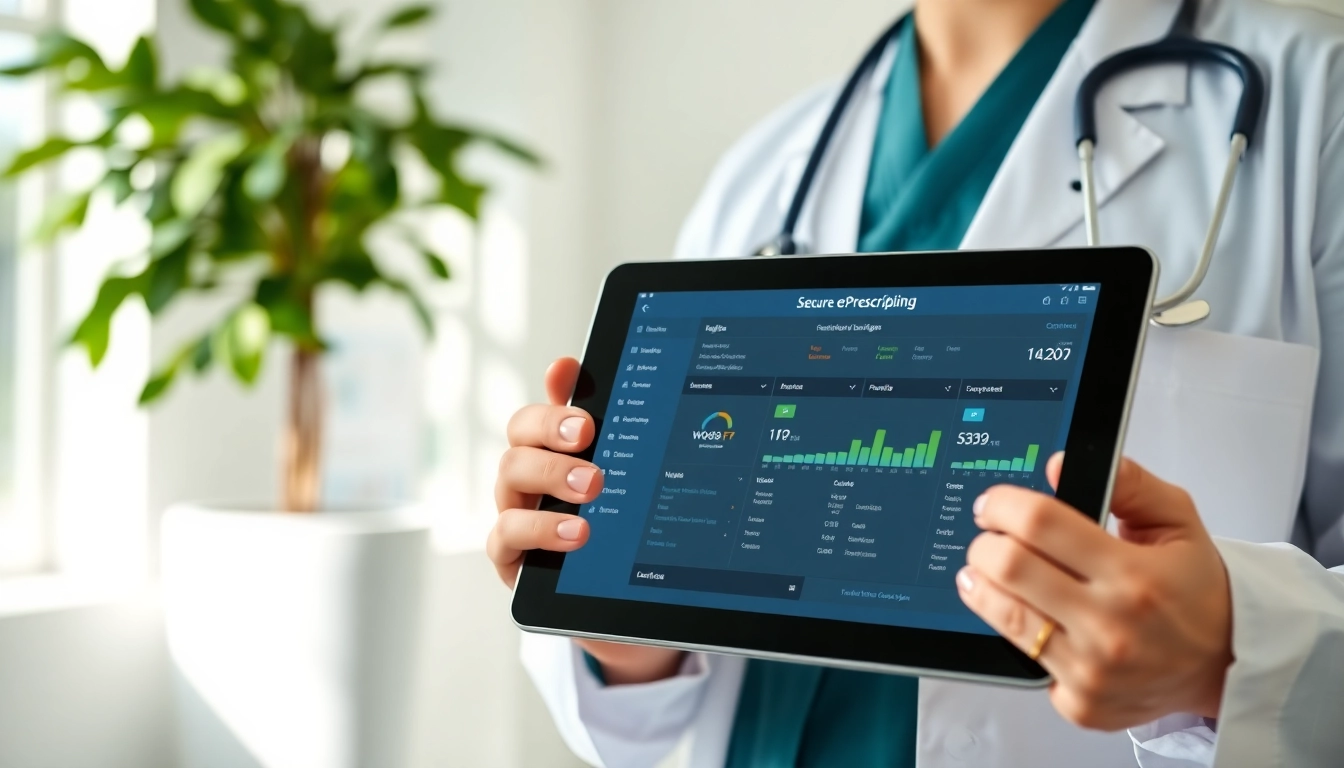In the ever-evolving landscape of healthcare technology, secure ePrescribing solutions have emerged as a transformative tool that enhances the prescription process for both providers and patients. These solutions not only aim to streamline the prescription workflow but also focus on significantly improving the safety, efficiency, and accuracy of medication dispensing. As healthcare systems grapple with increasing regulatory demands and the need for enhanced patient care, understanding the nuances of secure ePrescribing solutions becomes critical for medical professionals and organizations alike. By integrating secure eprescribing solutions into their practices, healthcare providers can ensure that they are not only compliant with regulations but also dedicated to maintaining high standards of patient safety.
Understanding Secure ePrescribing Solutions
Definition and Importance
Secure ePrescribing solutions refer to electronic systems used by healthcare providers to prescribe medications digitally, replacing the traditional paper-based system. These digital solutions are designed with advanced security features to safeguard against unauthorized access, ensuring that patient information and prescription data remain confidential and protected.
The importance of secure ePrescribing solutions cannot be overstated. With a dramatic rise in medication errors attributed to manual processes, the integration of secure ePrescribing technology addresses critical safety issues. By minimizing the physical handling of prescriptions, these systems reduce the risk of illegible handwriting and other common errors that can occur in traditional prescription methods. Moreover, they facilitate quick updates to medication dosages and streamline communication between prescribers, pharmacists, and patients.
How ePrescribing Works
ePrescribing functions through a series of connected software and healthcare applications. When a healthcare provider decides to prescribe a medication, they enter the prescription details into a secure ePrescribing platform. This platform communicates directly with a network of pharmacies, allowing for swift verification and fulfillment of the prescription.
The workflow typically involves the following steps:
- The provider logs into the ePrescribing system and selects the appropriate medication for the patient.
- Dosage and instructions are entered into the system along with the patient’s information.
- The system automatically checks for drug interactions and allergies, ensuring patient safety.
- The encrypted prescription is sent directly to the selected pharmacy electronically.
- The pharmacy receives the prescription and processes it for fulfillment.
- Notifications are sent to both the provider and the patient regarding the prescription status, enabling real-time tracking and communication.
Key Features of Secure ePrescribing Solutions
Innovative secure ePrescribing solutions are characterized by numerous features designed to enhance their functionality and reliability:
- Security Protocols: Robust encryption methods protect sensitive data during transmission between providers, patients, and pharmacies.
- Drug Interaction Checks: Automatic alerts notify prescribers of any potential drug interactions and allergy warnings, enhancing patient safety.
- User-Friendly Interface: Intuitive designs enable easy navigation for providers, reducing the learning curve associated with new technologies.
- Integration with Electronic Health Records: Smooth integration with existing EHR systems allows for comprehensive patient profiles that inform prescribing decisions.
- Support for Controlled Substances: Advanced authentication methods meet regulatory standards for electronically prescribing controlled substances, increasing compliance and security.
Benefits of Implementing Secure ePrescribing Solutions
Improved Patient Safety
One of the most significant advantages of deploying secure ePrescribing solutions is the marked improvement in patient safety. By minimizing manual entry and facilitating better data accuracy, these systems drastically reduce the likelihood of medication errors. Automated checks for allergies and drug interactions proactively alert clinicians to potential risks before a prescription is finalized.
Moreover, the ability to track and verify prescriptions electronically prevents discrepancies and enhances accountability in the treatment process. This focus on safety not only fosters trust between patients and healthcare providers but also fortifies the overall integrity of the healthcare system.
Increased Efficiency for Healthcare Providers
Secure ePrescribing solutions streamline the entire prescribing process, allowing healthcare professionals to spend more time focusing on patient care rather than administrative tasks. Automatic prescription renewals and refill requests eliminate tedious paperwork and follow-ups.
Additionally, real-time access to patient medication histories equips providers with the necessary information to make informed prescribing decisions swiftly, leading to enhanced workflow efficiency. With the ability to send prescriptions directly to the pharmacy, providers can significantly cut down on wait times and improve overall service delivery.
Reduction of Medication Errors
Medication errors represent one of the most significant challenges in contemporary healthcare. According to studies, a substantial percentage of medication errors occur during the prescribing phase. Transitioning to secure ePrescribing solutions addresses this issue by ensuring accuracy and clarity. The elimination of handwritten prescriptions reduces confusion and misinterpretations, leading to fewer discrepancies.
Furthermore, the automatic alerts regarding potential interactions or allergies serve as an additional layer of defense against medication errors, ensuring that the prescribed treatment aligns with the patient’s medical history.
Choosing the Right Secure ePrescribing Solutions
Evaluating Your Practice’s Needs
Selecting a secure ePrescribing solution requires a comprehensive assessment of a practice’s unique requirements. Factors to consider include the size of the practice, the patient population served, and specific prescribing needs. It is essential to engage stakeholders early in the evaluation process and solicit input from various departments, including clinical staff, billing, and IT, to ensure that the chosen solution aligns with the organization’s operational capacities.
Comparing Features and Pricing
Once practice needs are identified, comparison of various secure ePrescribing platforms should focus on critical features and pricing models. Certain platforms may offer advanced features such as analytics tools, patient engagement modules, or enhanced security protocols; understanding these functionalities in relation to their costs is crucial for informed decision-making.
Additionally, long-term value and total cost of ownership should be assessed rather than merely initial setup costs. Many vendors provide tiered pricing structures based on user volume or features, allowing for tailored solutions that suit diverse financial budgets.
Understanding Compliance and Regulatory Requirements
Secure ePrescribing solutions must comply with industry regulations and standards, including those established by federal entities such as the Drug Enforcement Administration (DEA) and state healthcare boards. Engaging with a solution provider that emphasizes compliance ensures that practices mitigate risks associated with regulatory breaches and can effectively navigate the complex landscape of ePrescribing legislation.
Additionally, ongoing training and education regarding evolving regulations will be necessary. Staying informed about best practices helps ensure that providers can maintain compliance while delivering high-quality care.
Challenges in Adopting Secure ePrescribing Solutions
Technological Barriers
The transition to secure ePrescribing can pose numerous technological challenges, particularly for practices not accustomed to digital systems. Concerns regarding usability, data security, and the infrastructure required for implementation are common barriers to adoption. Practices must invest in training to ensure that all staff members are proficient in using the new platform and possess the ability to troubleshoot minor issues that may arise during daily operations.
Moreover, considering technological upgrades, such as improved internet connectivity and hardware, may be necessary to accommodate the new system efficiently. Partnering with vendors who provide robust customer support and training resources can also alleviate these concerns, enabling smoother transitions.
Resistance from Healthcare Professionals
Some healthcare professionals may exhibit resistance to adopting new technologies due to fear of change or concerns over the adequacy of training. Emphasizing the benefits of secure ePrescribing solutions, including improved patient care and streamlined workflows, can help counter these apprehensions. Involving staff in the selection process can also foster a sense of ownership and encourage enthusiastic adoption of the new system.
Regular feedback sessions can help gauge user comfort levels and facilitate ongoing adjustments to procedures, gradually eroding resistance to technological advances.
Integration with Existing Systems
Integration with existing Electronic Health Records (EHR) systems can be challenging but essential for maximizing the value of secure ePrescribing solutions. Providers should assess compatibility with current systems to ensure seamless data exchange that supports comprehensive patient care.
Strategies such as implementing middleware solutions or ensuring that the selected ePrescribing platform has robust APIs can facilitate smoother integration. Additionally, creating a phased rollout strategy can minimize disruption, allowing for troubleshooting and adjustments without significantly impacting everyday operations.
Measuring the Success of Secure ePrescribing Solutions
Key Performance Indicators (KPIs)
Measuring the success of secure ePrescribing implementations is vital for ongoing evaluation and improvement. Key Performance Indicators (KPIs) to monitor include the frequency of medication errors, prescription fill rates, as well as turnaround times for prescriptions. Other metrics like user satisfaction surveys, system uptime statistics, and rates of compliance with filling prescriptions can provide insights into the overall effectiveness of the systems utilized.
Utilizing data analytics tools allows tracking of these KPIs over time, revealing trends and areas for improvement within the prescribing process. Regularly assessing performance based on these metrics is ideal for ensuring continual enhancement and optimizing patient care.
Patient Feedback and Satisfaction
Patient feedback plays an essential role in evaluating the efficacy of secure ePrescribing solutions. Understanding patient satisfaction regarding the ease of obtaining prescriptions, communication with healthcare providers, and overall confidence in the system greatly informs potential areas for bolstering service delivery.
Conducting surveys following prescription fulfillment and creating channels for patients to provide feedback can help gather valuable insights that guide improvements and highlight successes. Listening to patient perspectives enhances the relationship between healthcare providers and patients while reinforcing a commitment to high-quality service.
Long-term Benefits Analysis
Ultimately, the long-term benefits of implementing secure ePrescribing solutions must be evaluated to justify ongoing investments. Considering metrics such as improved patient outcomes, increased adherence to prescribed therapies, and overall cost savings helps quantify the advantages associated with digital prescription processes.
Furthermore, analyzing operational efficiencies gained through reduced paperwork and administrative tasks facilitates a deeper understanding of return on investment (ROI) over time. Documenting these benefits assists practices in navigating future technological enhancements and solidifies commitment to ePrescribing initiatives.
Conclusion
As the healthcare industry continues to grapple with challenges of efficiency, safety, and compliance, the importance of secure ePrescribing solutions becomes increasingly clear. Emphasizing improved patient safety, enhanced workflows, and reduced medication errors are crucial components that contribute to the transformative potential of these technologies. By carefully selecting and implementing the right secure ePrescribing solutions, practices can navigate the complexities of modern healthcare while ensuring the highest levels of care for their patients. Striving for excellence in this area not only enriches the patient experience but also establishes healthcare providers as leaders in the ongoing pursuit of innovative solutions that fundamentally reshape the future of care.



